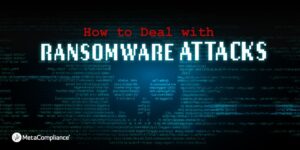How to Deal with Ransomware Attacks
Published on: 10 Mar 2020
Last modified on: 17 Dec 2025

Ransomware is one of the most serious cyber security threats facing organisations worldwide today. Its impact can be devastating, causing operational disruption, financial loss and long-term reputational damage.
Cybercriminals have shifted their focus away from individual consumers and are now targeting businesses, public sector bodies and critical services where the potential financial return is far greater.
Recent research shows that ransomware attacks against businesses have increased dramatically, with incidents rising by over 363% in a single year. In 2019 alone, more than 61 million ransomware attacks were detected globally, highlighting just how widespread and persistent this threat has become.
The industries most frequently targeted include local government, education, technology, healthcare, manufacturing, financial services and media organisations. However, no sector is immune. Every organisation, regardless of size or industry, must take proactive steps to reduce its risk of a ransomware attack.
Despite the growing threat, many organisations still underestimate the seriousness of ransomware. It is often only after suffering a major attack that sufficient time, budget and resources are invested in cyber security. Unfortunately, by that stage, the damage has usually already been done.
What is Ransomware?
Ransomware is a form of malware that blocks access to systems or data by encrypting files and demanding a ransom payment for their release. Payments are typically requested in cryptocurrencies such as Bitcoin, making transactions difficult to trace.
Attackers often impose strict deadlines for payment. If the ransom is not paid within the specified timeframe, the demand may increase or the encrypted files may be permanently deleted.
Some ransomware variants are capable of spreading rapidly across networks. A notable example is the 2017 WannaCry attack, which infected hundreds of thousands of devices across more than 150 countries and caused major disruption, including widespread outages across the UK’s NHS.
How Do You Get Ransomware?
Ransomware commonly enters systems through phishing emails containing malicious links or attachments. These emails are designed to appear legitimate, often impersonating trusted organisations or colleagues. Once a link is clicked or an attachment opened, the malware installs itself and begins encrypting files.
Other delivery methods include compromised Remote Desktop Protocol (RDP) connections, malicious or infected websites, removable media devices such as USB drives, and even social media messaging platforms.
What to Do in the Event of a Ransomware Attack
1. Isolate infected machines
Immediately disconnect any suspected infected devices from the network by disabling Wi-Fi, Bluetooth and unplugging network cables. This helps prevent the ransomware from spreading to other systems.
2. Notify your IT security team
Alert your IT or cyber security team straight away so they can activate your incident response plan. A structured response ensures evidence is preserved, the threat is contained and recovery efforts are handled efficiently.
3. Identify the type of ransomware
Identifying the ransomware strain can help determine how it spreads, which files are affected and whether decryption tools are available. Encrypting ransomware is significantly more damaging than screen-locking variants.
4. Inform employees
Communicate clearly with staff about the incident, expected disruption and next steps. Transparency helps reduce panic and ensures employees follow correct security procedures during the response.
5. Change login credentials
Reset all user and administrative credentials immediately. Stolen credentials allow attackers to move laterally across networks and compromise backups.
6. Take a photo of the ransom note
Capture the ransom message using a mobile device. This can be valuable evidence for law enforcement, insurers and forensic investigations.
7. Notify the authorities
Report the incident to the police and, where applicable, the ICO. Under GDPR, organisations handling EU citizen data must notify the ICO within 72 hours of a qualifying breach.
8. Never pay the ransom
Paying a ransom encourages further criminal activity and offers no guarantee of data recovery. Organisations that pay are also more likely to be targeted again.
9. Update security systems
Conduct a full security audit and ensure all systems are patched and up to date. Regular updates reduce the risk of attackers exploiting known vulnerabilities.
10. Recover from backups
Reliable, up-to-date backups are essential for recovery. Following the 3-2-1 backup rule ensures data can be restored without resorting to ransom payments.
How to Prevent Ransomware Attacks
- Provide regular cyber security awareness training for employees.
- Back up critical data frequently and test recovery processes.
- Limit user permissions to reduce malware spread.
- Apply software updates and security patches promptly.
- Install and maintain anti-virus and endpoint protection tools.
- Scan incoming and outgoing emails for threats.
- Avoid clicking unknown links or downloading suspicious attachments.
- Configure firewalls to block malicious IP addresses.
- Use strong passwords and enable multi-factor authentication.
Learn More About MetaCompliance Solutions
Building effective ransomware defence starts with reducing human risk and strengthening awareness across your organisation. MetaCompliance provides a comprehensive range of solutions designed to prevent phishing attacks, improve cyber resilience and support long-term security maturity through our Human Risk Management Platform, including:
- Automated Security Awareness
- Advanced Phishing Simulations
- Risk Intelligence & Analytics
- Compliance Management
To discover how these solutions can help protect your organisation from ransomware and phishing threats, contact us today to book a demo.
How To Deal With Ransomware Attacks – FAQs
What is the main cause of ransomware attacks?
Phishing emails are the most common entry point for ransomware, often tricking users into opening malicious links or attachments.
Should a business ever pay a ransomware ransom?
No. Paying the ransom does not guarantee data recovery and increases the likelihood of future attacks.
Can ransomware be removed without paying?
In some cases, yes. Recovery may be possible through backups or available decryption tools, depending on the ransomware strain.
How can organisations best prevent ransomware?
Regular staff training, strong email security, up-to-date systems and phishing simulations are among the most effective prevention measures.